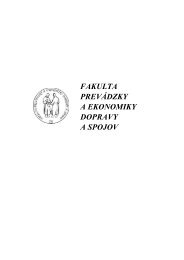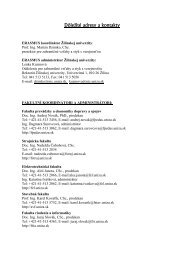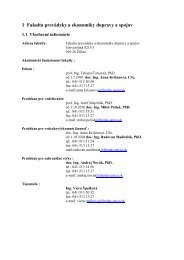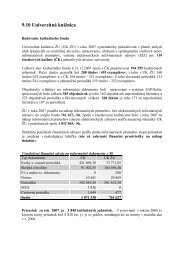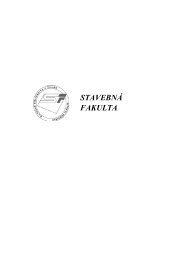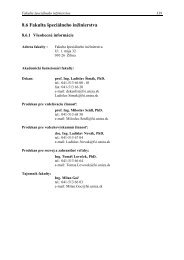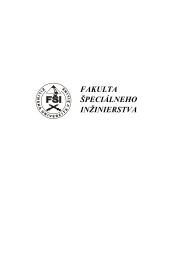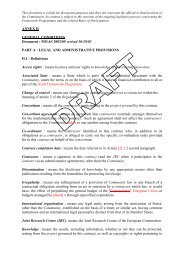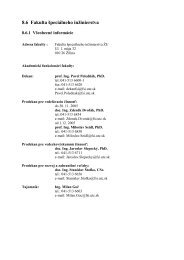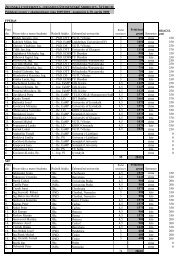posudzovanie vplyvu automobilovej dopravy na - Žilinská univerzita
posudzovanie vplyvu automobilovej dopravy na - Žilinská univerzita
posudzovanie vplyvu automobilovej dopravy na - Žilinská univerzita
Create successful ePaper yourself
Turn your PDF publications into a flip-book with our unique Google optimized e-Paper software.
C O M M U N I C A T I O N S<br />
I S<br />
šírky zeleného pásu. Výraznejšie tlmenie sa prejavuje od šírky 15 –<br />
– 20 m. V zelenom páse je vhodná kombinácia stromov a kríkov,<br />
aby hluk prenikal čo <strong>na</strong>jmenej. Odporúča sa kombinácia list<strong>na</strong>tých<br />
a ihlič<strong>na</strong>tých drevín, <strong>na</strong>koľko list<strong>na</strong>té vo vegetačnom kľude nemajú<br />
vplyv <strong>na</strong> zníženie hluku. Zníženie hlukovej energie spočíva vo veľkom<br />
množstve odrazov od listov, konárov a ihličia, teda nie v pohlcovaní.<br />
Protihlukové clony<br />
Osadenie protihlukových clôn, stien a valov pozitívne pôsobí<br />
aj <strong>na</strong> rozptyl emisií. Ste<strong>na</strong> síce tvorí bariéru, ktorá ovplyvní koncentráciu<br />
plynných látok v blízkosti komunikácie, ale pri jej vhodnom<br />
umiestnení redukuje túto hodnotu v oblasti za stenou, kde dochádza<br />
k zníženiu koncentrácie. Pokiaľ je teda vybudovaný chodník<br />
pre peších za protihlukovou stenou, sú dosahované koncentrácie<br />
v ovzduší nižšie.<br />
can be seen starting from the width of 15 – 20 m. In the green belt<br />
it is appropriate to combine trees and bushes, so that as little noise<br />
passes through as possible. It is recommended to combine deciduous<br />
and coniferous species, because the deciduous species have<br />
no effect on noise protection during their vegetative standstill. The<br />
reduction of noise energy is the result of the large amount of noise<br />
reflected on the leaves, branches and needles, not of absorption.<br />
Noise Barriers<br />
Construction of noise barriers has got positive influence also<br />
on the emission dispersion. A wall makes a barrier that affects the<br />
concentration of gaseous substances near the road, however, if it<br />
is properly situated, it reduces this value in the area behind the<br />
wall. Therefore, if footpaths are constructed behind noise barriers,<br />
the concentrations in the air are lower.<br />
Obr. 7 Vplyv protihlukovej steny <strong>na</strong> redukciu imisií<br />
(rýchlosť vetra 2m.s 1 )<br />
Fig. 7 Effect of the noise barrier on the emission reduction<br />
(wind velocity 2m.s 1 )<br />
Obr. 8 Porov<strong>na</strong>nie účinku zelene, protihlukovej steny<br />
a zemného valu [3] (š – šírka, h – výška)<br />
Fig. 8 Comparison of the effect of greenery, noise wall<br />
and embankment [3]<br />
Z uvedených porov<strong>na</strong>ní vyplýva, že problematiku dopadu<br />
<strong>dopravy</strong> <strong>na</strong> znečistenie ovzdušia v mestách je potrebné riešiť už<br />
<strong>na</strong> úrovni územnoplánovacej dokumentácie, kde sa rozhoduje<br />
o umiestnení komunikácií, pričom je nevyhnutné porovnávanie<br />
variantných riešení.<br />
4. Možnosti ovplyvnenia produkcie emisií<br />
Redukovanie zdroja škodlivín predstavuje ovplyvňovanie intenzity<br />
<strong>dopravy</strong> zmenou dopravných tokov, znižovaním podielu nákladných<br />
vozidiel, obmedzovaním rýchlosti, čo možno dosiahnuť dopravným<br />
z<strong>na</strong>čením a zosúladením režimu <strong>dopravy</strong> v rámci komunikačného<br />
systému (zelené vlny).<br />
V grafoch <strong>na</strong> obr. 10 a 11 sú uvedené porovnávacie údaje vypočítané<br />
pre rov<strong>na</strong>ko smerovo orientovaný úsek komunikácie dlhý<br />
jeden km, šírkové usporiadanie MS 21,5 pre mestský režim jazdy vozidiel,<br />
čo zodpovedá zbernej komunikácii (MS) a rýchlostnej komunikácii<br />
R 22,5 pre mimomestský (plynulý) režim jazdy. Uvažovaný<br />
počet osobných vozidiel bol 10 000/24 h, nákladných 1000/24 h,<br />
špičková polhodinová doprava bola uvažovaná hodnotou 5 % z celodennej<br />
24-hodinovej <strong>dopravy</strong>. Výpočet je uskutočnený podľa metodiky<br />
SAV [4].<br />
It can be seen from the presented comparisons that it is necessary<br />
to solve the impact of the traffic on air pollution already at<br />
the stage of land planning documentation, where the location of<br />
the roads is determined.<br />
4. Possibilities of the Influencing the Production<br />
of Emissions<br />
To reduce sources of pollutants means to influence traffic<br />
intensity by changing traffic flows, reducing the number of trucks,<br />
limiting speed, which can be achieved by road signs and synchronization<br />
of the traffic mode in terms of the communication system<br />
(green waves).<br />
Figures 9 and 10 show comparative data calculated for a 1 km<br />
long road section with the same directio<strong>na</strong>l orientation with the<br />
wideness category of MS 21.5 for urban driving mode, which corresponds<br />
to a local distributor road (MS) and a R22.5 expressway<br />
for rural (fluent) driving mode. The assumed number of passenger<br />
cars was 10,000/24 hours, trucks 1,000/24 hours, the peak traffic<br />
in half an hour was assumed to be 5 % from the total all-day 24 hours<br />
traffic. The calculation was done according to the SAV (Slovak<br />
Science Academy) methodology. [4]<br />
KOMUNIKÁCIE / COMMUNICATIONS 1/2003 ●<br />
9



